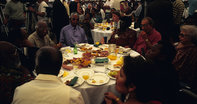
Lunch with Jailers Wives
It takes some special human quality for a man who spent 27 years of his life incarcerated in prison, the victim of a vicious system whose purpose was to keep him and his people subjugated in perpetual bondage, to entertain the widows and wives of his jailers to lunch.
That is what South Africa's President Nelson Rolihlahla Mandela did, five years after the jail doors were opened and he stepped out a free man, later to be elevated to the highest office in the country in what has been described as a miracle election.
Black Social Contact - Non Existent
Only a few years earlier these women were to be seen standing resolutely beside their husbands as they intoned the racial verities they had fashioned under the mantle of the policy of apartheid — the grandiose plan to force most of the country's 40-million people into subservience under iron-fisted laws imposed by the three million ruling Afrikaner Nationalists.
The women's social contact with black South Africans was non-existent -- though they deigned to shake the hands of foreign black diplomats because they fell into the artificially created "international" class of persons. South African blacks were hewers of wood and drawers of water, fit only for the menial tasks decreed by the policies their husbands had devised.
With that status went a variable degree of paternalistic care. And if black people did not behave or conform there was always banning, house arrest, banishment, prison or death. President Mandela himself had endured nearly half a lifetime of some of those punishments.
One Declined
Only one of apartheid's widows politely declined the invitation to lunch. Her husband, Dr Hendrik Frensch Verwoerd, was the grand architect of apartheid before being assassinated by a deranged parliamentary messenger in 1966.
He was the man who spent his adult life working out tortuous ways and means by which Afrikaner Nationalists could maintain their iron grip on the country and indulge their racial fantasies in the company of like-minded fellow whites in segregated suburbs while reaping the benefits and comfortable lifestyles made possible by the low-priced labour of blacks.
At the age of 94, Mrs Betsie Verwoerd pleaded that infirmity prevented her from travelling to Pretoria but, being a polite old lady, she softened the refusal with the formal suggestion that she would be pleased to meet the President should he pass by.
That meant the President would have to travel some 1 100 km (700 miles) to dry and dusty Orania in the Karoo in the upper reaches of the Northern Cape, where Afrikaner Nationalists have bought a tract of land and have begun establishing a "whites only" town. In the process, the coloureds (mixed race people) who had been living there were ejected.
In the light of this history and the studied rejection of everything black — in the new circumstances of a democratic South Africa the cheap labour policies of apartheid had to be foregone and everyone would do their own work even to cleaning the sewers -- there was little expectation that President Mandela would call.
Mandela Visits Orania
But this was hardly a consideration for a President who could entertain the widow of former Prime Minister John Balthazar Vorster. It was as Minister of Justice that Vorster matched Verwoerd's enthusiastic inventiveness by introducing a set of repressive laws which, apart from their excessively brutal features, nearly turned President Mandela and his fellow-prisoners into non-persons.
President Mandela flew down to Orania, had tea and koeksisters (a kind of sugared doughnut) with Mrs Verwoerd and with a hand on her shoulder and a smile playing around his lips, articulated in Afrikaans the words as she faltered while reading out the letter she had composed.
"I ask the President to consider the Volkstaat with sympathy and also to dispose of the fate of the Afrikaners with wisdom," her letter read. She was referring to the demand of Afrikaner Nationalists to be given their own "people's state" in which they would wield power without interference by the majority.
It was a somewhat bland way of seeking to set up their own apartheid enclave where they would be able to perpetuate the policy, while all around them the first democracy in South Africa would continue to demolish all vestiges of the hated policy.
President Mandela appeared unfazed by the paraphernalia of apartheid - such as the "strictly private" sign at the entrance to the town, the statue of Verwoerd with its "I have shown the way" symbolism and the absence of black faces in a country where blacks are in the majority in most towns. He deflected questions about the "whites only" style of the place by saying that he had not been required to ask permission to visit. It was a studied attempt to refuse to take umbrage.
 The reason President Mandela gave for entertaining the women — and it was his own idea — was a challenge to the country....
The reason President Mandela gave for entertaining the women — and it was his own idea — was a challenge to the country.... Nelson Rolihlahla Mandela is a former president of South Africa, the first to be democratically elected after the apartheid system was aboli...
Nelson Rolihlahla Mandela is a former president of South Africa, the first to be democratically elected after the apartheid system was aboli...